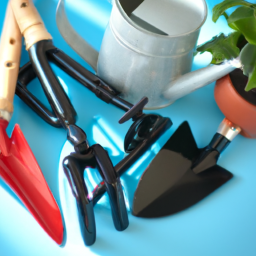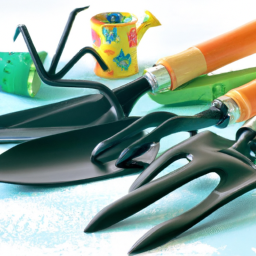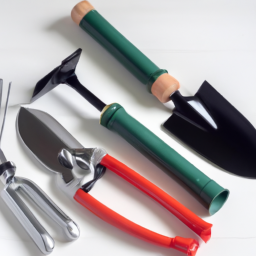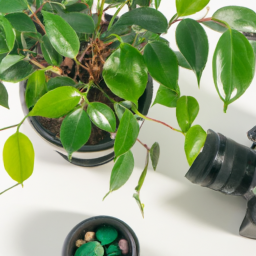
Are you a new gardener looking to bring the beauty of nature indoors? If so, you’ve come to the right place. In this blog post, we will discuss the indoor gardening essentials: tools every new gardener needs. Whether you have a small apartment or a spacious house, indoor gardening is a fantastic way to add greenery and life to your living space. By having the right tools at your disposal, you can create a thriving indoor garden that brings joy and tranquility to your home. So, let’s dive in and explore the must-have tools for any new indoor gardener.
The Importance of Proper Tools in Indoor Gardening
Indoor gardening has gained immense popularity in recent years, and for good reason. Not only does it provide a therapeutic and rewarding hobby, but it also allows you to bring the beauty of nature indoors. However, to ensure success in your indoor gardening endeavors, it is crucial to have the right tools at your disposal. In this article, we will explore the importance of proper tools in indoor gardening and provide you with a step-by-step guide on the essential tools every new gardener needs.
Why are proper tools important?
Just like any other task or hobby, having the right tools can make a world of difference in your indoor gardening experience. Here are a few reasons why proper tools are essential:
1. Efficiency: Using the right tools allows you to work more efficiently, saving you time and effort. Whether it’s pruning shears, a watering can, or a soil pH tester, each tool serves a specific purpose and helps you accomplish tasks with ease.
2. Precision: Indoor gardening often requires delicate and precise actions, such as transplanting seedlings or trimming leaves. With the right tools, you can perform these tasks accurately, ensuring the health and vitality of your plants.
3. Safety: Indoor gardening involves handling sharp objects, such as pruning shears or scissors. By using proper tools, you minimize the risk of accidents and injuries, allowing you to enjoy your gardening experience without any worries.
Essential Tools for Indoor Gardening
Now that we understand the importance of proper tools, let’s dive into the essential tools every new gardener needs for successful indoor gardening:
1. Pruning Shears: Pruning shears are a must-have tool for any indoor gardener. These specialized scissors are designed to trim and shape plants, allowing you to remove dead or damaged foliage, encourage new growth, and maintain the overall health of your plants.
2. Watering Can: A watering can is an essential tool for providing your indoor plants with the right amount of water. Look for a watering can with a narrow spout to ensure precise watering without causing waterlogging or splashing.
3. Soil pH Tester: Maintaining the proper pH level of your soil is crucial for the health and growth of your indoor plants. A soil pH tester helps you monitor the acidity or alkalinity of your soil, allowing you to make necessary adjustments to create an optimal growing environment.
4. Gardening Gloves: Protecting your hands while gardening is essential, especially when dealing with prickly plants or handling soil. Invest in a pair of sturdy gardening gloves that provide both comfort and protection.
5. Plant Mister: Many indoor plants thrive in humid environments. A plant mister allows you to provide a fine mist of water, creating the ideal humidity levels for your plants. It is especially useful for tropical plants or during dry winter months.
6. Plant Labels: Keeping track of your indoor plants is crucial, especially if you have multiple varieties. Plant labels help you identify and remember the specific care requirements of each plant, ensuring they receive the right amount of light, water, and nutrients.
7. Trowel: A trowel is a versatile tool that helps you dig, transplant, and loosen soil. Look for a trowel with a comfortable grip and a sturdy blade for easy maneuverability.
8. Grow Light: Inadequate sunlight can hinder the growth of indoor plants. A grow light provides the necessary artificial light spectrum to supplement natural sunlight, ensuring your plants receive adequate light for photosynthesis.
9. Plant Trays: Plant trays are essential for proper drainage and preventing water damage to your indoor surfaces. They collect excess water that drains out of the pots, keeping your plants and surroundings clean and dry.
10. Plant Pots: Lastly, invest in a variety of plant pots suitable for different sizes of plants. Choose pots with drainage holes to avoid waterlogging and ensure proper airflow to the roots.
By equipping yourself with these essential tools, you will be well-prepared to embark on your indoor gardening journey with confidence and success.
In conclusion, proper tools play a vital role in indoor gardening. They enhance efficiency, precision, and safety, allowing you to enjoy the process and achieve optimal results. From pruning shears to grow lights, each tool serves a unique purpose in nurturing your indoor plants. So, gather your tools, roll up your sleeves, and let your indoor garden thrive!

Must-Have Tools for Beginner Indoor Gardeners
Introduction
Starting an indoor garden can be an exciting and rewarding experience for beginners. Not only does it bring a touch of nature into your home, but it also allows you to grow your own fresh herbs, vegetables, and flowers all year round. To ensure your indoor garden thrives, there are a few essential tools every new gardener should have. In this guide, we will walk you through the must-have tools that will make your indoor gardening journey a breeze.
1. Quality Potting Soil
The foundation of any successful indoor garden is quality potting soil. Unlike outdoor gardening, indoor plants rely solely on the soil you provide them. Look for a potting mix specifically formulated for indoor plants, as it will have the right balance of nutrients and moisture retention. Avoid using garden soil, as it may contain pests and diseases that can harm your indoor plants.
When choosing potting soil, consider the type of plants you want to grow. Some plants, like succulents, prefer well-draining soil, while others, like tropical plants, thrive in soil with higher moisture content. Read the labels and select a potting mix that suits the needs of your plants.
2. Containers and Pots
Having the right containers and pots is essential for indoor gardening. Opt for containers with drainage holes to prevent waterlogging, which can lead to root rot. Plastic, ceramic, or terracotta pots are popular choices, each with its own benefits. Plastic pots are lightweight and retain moisture well, while ceramic and terracotta pots provide better insulation and airflow.
Consider the size of your plants when selecting containers. Ensure they have enough room for root growth, but avoid pots that are excessively large, as they can hold too much moisture and lead to overwatering. Additionally, choose pots that complement your indoor decor, as they can add a touch of style to your living space.
3. Watering Can or Spray Bottle
Proper watering is crucial for the health of your indoor plants. A watering can or spray bottle is a must-have tool for every indoor gardener. The choice between the two depends on the size and type of plants you have.
For larger plants, a watering can with a long spout allows you to reach the soil without disturbing the foliage. This ensures water goes directly to the roots where it’s needed. On the other hand, a spray bottle is ideal for smaller plants or those that require misting, such as orchids or ferns. It allows you to control the amount of water and provides gentle hydration.
4. Pruning Shears
Pruning shears are indispensable tools for maintaining the health and appearance of your indoor plants. Regular pruning helps promote bushier growth, removes dead or damaged leaves, and prevents the spread of diseases. Look for pruning shears with sharp blades and comfortable handles for ease of use.
Before pruning, sterilize your shears with rubbing alcohol to prevent the transmission of pathogens. When making cuts, angle them slightly above a leaf node or bud. This encourages new growth and helps your plants maintain their shape. Remember to clean and oil your pruning shears after each use to keep them in optimal condition.
5. Plant Labels
Keeping track of your indoor plants is essential, especially if you have a variety of species. Plant labels are an inexpensive tool that can help you identify and remember the specific care requirements of each plant. They can be as simple as popsicle sticks or decorative labels that add a personal touch to your indoor garden.
Write down the names of your plants, their watering schedules, and any other important information. This will prevent confusion and ensure you provide the right care for each plant. Additionally, labels can be a fun way to showcase your creativity by adding drawings or decorative elements.
Conclusion
As a beginner indoor gardener, having the right tools is crucial for the success of your plants. From quality potting soil to pruning shears and plant labels, each tool plays a vital role in creating a thriving indoor garden. Remember to choose tools that suit the needs of your plants and complement your indoor decor. With these must-have tools at your disposal, you’ll be well-equipped to embark on your indoor gardening journey. Happy gardening!

Essential Indoor Gardening Equipment for Successful Plant Growth
Introduction
Indoor gardening has become increasingly popular among plant enthusiasts, especially for those living in urban areas or with limited outdoor space. With the right tools and equipment, anyone can create a thriving indoor garden and enjoy the benefits of lush greenery and fresh produce. In this guide, we will explore the essential indoor gardening equipment that every new gardener needs to ensure successful plant growth. From lighting to watering tools, we’ve got you covered.
Lighting
1. Grow Lights
One of the most critical factors for successful indoor gardening is providing adequate lighting for your plants. Since natural sunlight may not always be sufficient, especially during the winter months or in homes with limited windows, investing in grow lights is essential. LED grow lights are highly recommended for indoor gardening due to their energy efficiency and ability to mimic natural sunlight. They come in various sizes and spectrums, allowing you to choose the right light intensity and color for different stages of plant growth.
2. Light Timer
To ensure consistent and appropriate lighting for your indoor garden, a light timer is a must-have tool. It allows you to set a specific schedule for your grow lights, mimicking natural daylight and darkness periods. This helps maintain a consistent growth cycle for your plants, promoting healthy development and preventing issues like overexposure or underexposure to light.
3. Light Meter
For precise light measurement and monitoring, a light meter is indispensable. It helps you determine if your plants are receiving adequate light levels for optimal growth. By measuring the intensity of light in foot-candles or lux, you can adjust the positioning and intensity of your grow lights accordingly. This tool is particularly useful for light-sensitive plants that require specific light conditions.
Watering Tools
1. Watering Can
A good-quality watering can is an essential tool for any gardener, whether indoor or outdoor. Opt for a can with a long spout that allows for precise watering without causing unnecessary splashing or damage to delicate plants. Look for a design that is comfortable to hold and easy to pour, ensuring a smooth watering experience.
2. Spray Bottle
In addition to a watering can, a spray bottle is a handy tool for indoor gardening. It is particularly useful for plants that prefer higher humidity levels or for misting foliage to prevent dust buildup. Choose a spray bottle with a fine mist setting to avoid damaging leaves or creating water droplets that can attract pests or cause fungal issues.
3. Moisture Meter
To prevent overwatering or underwatering your plants, a moisture meter is a valuable tool. It measures the moisture content in the soil, allowing you to determine when it’s time to water or if the soil is still adequately moist. This helps prevent root rot or dehydration, ensuring your plants thrive in the right moisture conditions.
Potting and Pruning Tools
1. Potting Soil
Choosing the right potting soil is crucial for indoor gardening success. Look for a well-draining mix specifically formulated for indoor plants. Avoid using garden soil, as it can become compacted and hinder root growth. Consider adding organic matter or perlite to improve drainage and provide essential nutrients to your plants.
2. Pruning Shears
Regular pruning is essential for maintaining healthy and attractive indoor plants. Invest in a pair of high-quality pruning shears to trim away dead or damaged leaves, promote bushier growth, and shape your plants. Look for shears with a comfortable grip and sharp blades for clean cuts without crushing the stems.
3. Plant Labels
Keeping track of your indoor garden’s plant varieties is essential, especially if you have multiple species. Plant labels are simple yet effective tools for labeling your pots or containers. They help you remember the specific care requirements of each plant, such as watering frequency, light preferences, or fertilization needs. This ensures that you provide the right care for each plant, promoting their overall health and growth.
Conclusion
Equipping yourself with the essential tools for indoor gardening sets the foundation for successful plant growth. From lighting to watering and potting tools, each item plays a crucial role in creating a thriving indoor garden. Remember to choose high-quality equipment that suits your specific needs and the requirements of your plants. With the right tools and a little bit of care, you’ll be well on your way to enjoying the beauty and benefits of indoor gardening. Happy gardening!
I’ll leave you with these final thoughts
Indoor gardening is a fantastic way to bring nature into your home and enjoy the benefits of plants, even if you don’t have a garden. However, to ensure your indoor garden thrives, it’s essential to have the right tools on hand. Whether you’re a newbie or experienced gardener, there are a few essentials that every indoor gardener should have in their arsenal.
First and foremost, a good pair of gardening gloves is a must-have. These will not only protect your hands from dirt and thorns but also provide a better grip when handling plants. Additionally, a sturdy pair of pruning shears is indispensable for trimming and shaping your plants, promoting healthy growth. Another essential tool is a watering can or spray bottle to ensure your plants receive the right amount of water without over-soaking them. Lastly, a small trowel or hand shovel is handy for transplanting and repotting your plants. With these essential tools, you’ll be well-equipped to start and maintain a thriving indoor garden, bringing life and beauty to your living space.
Here are some FAQs you’d be interested in:
Q1: What tools do I need to start indoor gardening?
A1: To start indoor gardening, you will need a few essential tools. First, you’ll need a set of gardening gloves to protect your hands while working with soil and plants. Additionally, a watering can or a spray bottle will be necessary to provide your plants with the right amount of water. A small shovel or a trowel will come in handy for planting and transplanting. Lastly, make sure to have a pair of pruning shears or scissors for trimming and shaping your plants.
Q2: Do I need any specific lighting equipment for indoor gardening?
A2: Yes, lighting is crucial for indoor gardening as it helps simulate natural sunlight. If you don’t have access to sufficient natural light, you’ll need to invest in artificial lighting. LED grow lights are popular among indoor gardeners due to their energy efficiency and ability to provide the necessary light spectrum for plant growth. Look for lights specifically designed for plants, as they emit the right wavelengths needed for photosynthesis.
Q3: Should I use specific types of soil for indoor gardening?
A3: Yes, choosing the right soil is important for indoor gardening success. Opt for a high-quality potting mix that is well-draining and rich in organic matter. Avoid using garden soil or soil from your yard, as they can be too heavy and may contain pests or diseases. Potting mixes are specially formulated to provide the right balance of nutrients, moisture retention, and aeration for indoor plants.
Q4: How often should I water my indoor plants?
A4: The watering frequency for indoor plants can vary depending on factors such as the type of plant, pot size, and environmental conditions. As a general rule, it’s best to check the soil moisture before watering. Stick your finger about an inch deep into the soil; if it feels dry, it’s time to water. Overwatering can lead to root rot, so it’s important to avoid keeping the soil overly saturated. On average, most indoor plants require watering once or twice a week.
Q5: Are there any additional tools or accessories that can enhance my indoor gardening experience?
A5: Absolutely! There are several tools and accessories that can enhance your indoor gardening experience. A moisture meter can help you accurately monitor the moisture levels in the soil. Plant misters or humidifiers can be beneficial for plants that require higher humidity levels. Additionally, having a plant stand or shelving unit can help maximize space and create an aesthetically pleasing display. Lastly, consider investing in a timer for your grow lights to ensure consistent lighting durations for your plants.
Dr. Olivia Green is a botanist with over two decades of experience in indoor plant cultivation. She holds a Ph.D. in Plant Biology and has dedicated her career to researching plant behavior in controlled environments. Dr. Green is passionate about helping plant enthusiasts master the art of indoor gardening through her extensive knowledge and practical insights.


